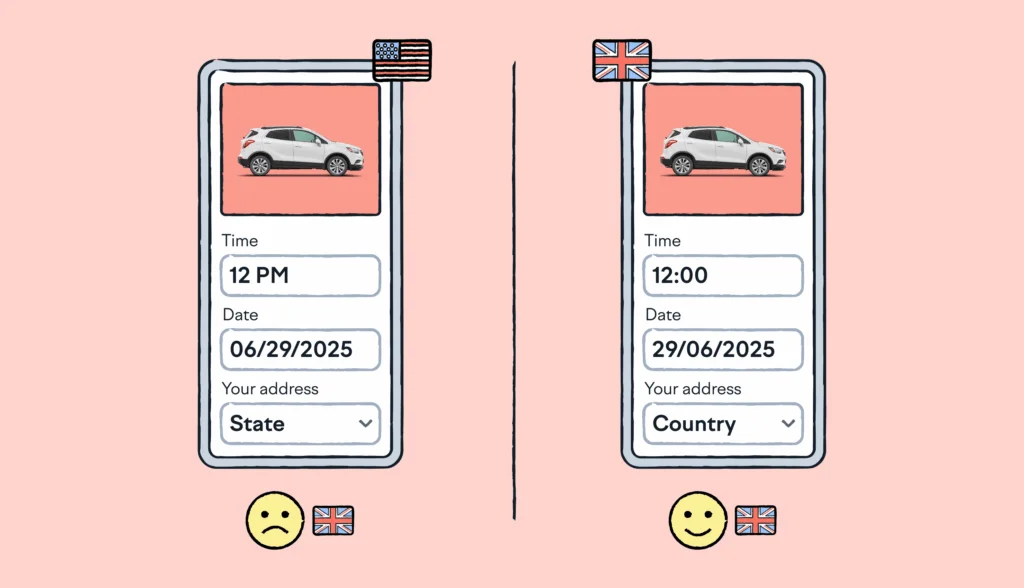You can’t become a global brand without localization. You also can’t do localization without a solid localization strategy.
As luck would have it, we hosted a webinar all about defining and refining the entire localization strategy-making process.
During the 30-minute webinar, Tatiana Ryabinina, localization expert and Managing Director at Grow-thru, talks about how localization is more about strategy and change management than just following best practices or project and process management.
Tatiana has helped managers and teams drive international growth by bringing their vision of localization to life. She knows how (and how not) to scale from 4 countries to 28 in 18 months with a localization team of one.
Before you get knee-deep into this article, a few action items:
• Watch Tatiana’s entire localization strategy-making process here
• Download her winning localization guide here
• If you haven’t already, sign up for the next webinar in this series
How to define or refine your localization strategy
Localization is more than just translating content.
It’s about aligning your team’s efforts with your business goals. A strong localization strategy should clarify what it means for your business, how it will be executed, how success will be measured, and what the costs and expected revenue are.
Tatiana’s insights from over a decade of experience can help you create a strategy that gets everyone on board and guides your decisions. This will not only prepare your company for the localization journey but also help you understand its potential in different markets.
Know that localization is not a one-size-fits-all process
You can localize across multiple dimensions, adapting parts of your value proposition to meet local market conditions. This could mean language translation, software and hardware adaptation, understanding cultural nuances, or changing business practices. However, the more you adapt, the more complex your strategy becomes, making it less scalable. Therefore, finding the right balance is crucial.
The more of your value proposition you adapt, the more complex your localization strategy becomes, making the process less scalable. So it’s crucial to find the right balance.
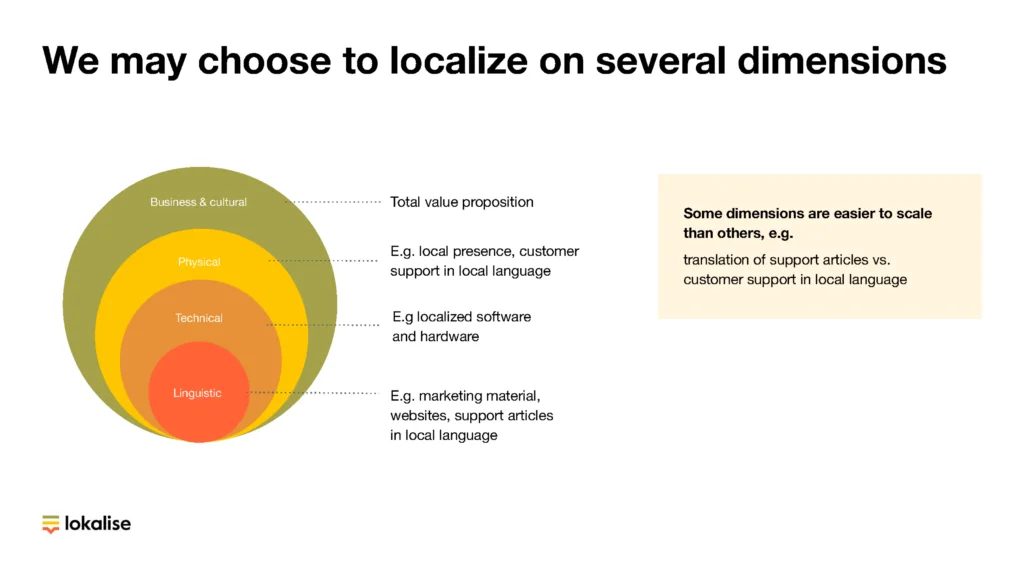
Make sure localization aligns with each team’s goals
Teams are often afraid that if they introduce localization into their workflows, which is already seen as a huge technical challenge, they won’t be able to communicate the same way in different languages and deliver the same customer experience. Plus, they worry that there will be a lot of work associated with localization that’s difficult to coordinate or deliver on time.
If localization already seems such a pain, do you think that these teams would also be willing to change the way they work?
To overcome this hurdle, you need to make sure that localization aligns with each team’s goals, ways of working, and the standards that they set for their work. Otherwise, they will resist localization and won’t be invested in making it a success. This is especially true when considering the role of software internationalization in enhancing your product’s adaptability across global markets.
The strategy team needs to help all teams understand how localization decisions are made.
Identify challenges early on
There are many challenges that you’ll encounter while rolling out localization, some of which you’ll be able to foresee. Add these to your strategy so you can plan ahead and let teams know how to tackle these challenges when they arise.
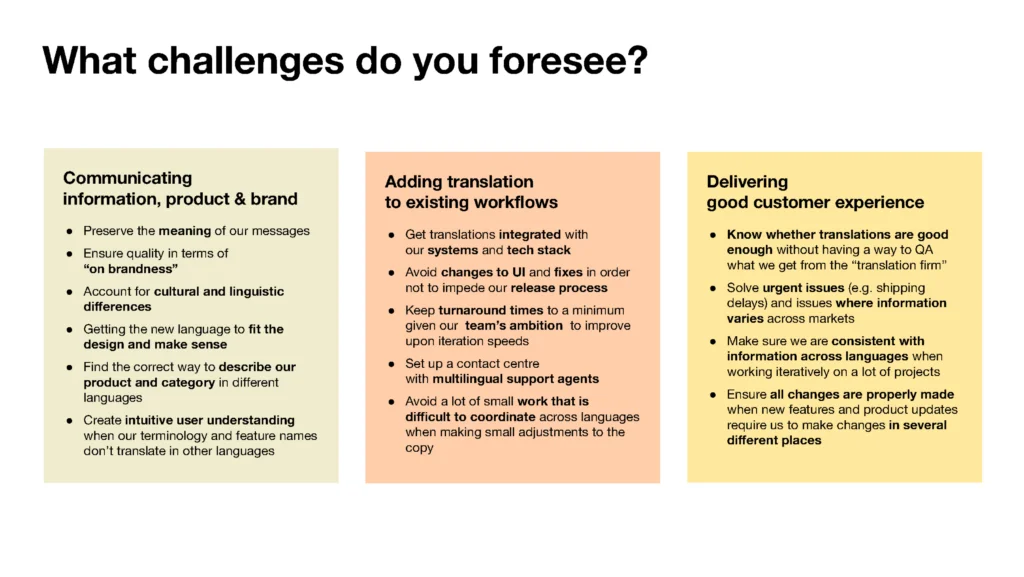
Divide localization into two levels
You need an intuitive way to explain to stakeholders what’s being localized and why. That’s why Tatiana recommends dividing localization into two steps:
| Marketing | Sales | Product | Support | Goal | |
| Step 1 | Localize customer surfaces and touchpoints | To increase sales and customer satisfaction | |||
| Step 2 | Sell through local partners and tailor processes to local norms | ||||
Customer surfaces and touchpoints that require localization can include everything from marketing emails and videos showing how to use the product to the product returns portal.
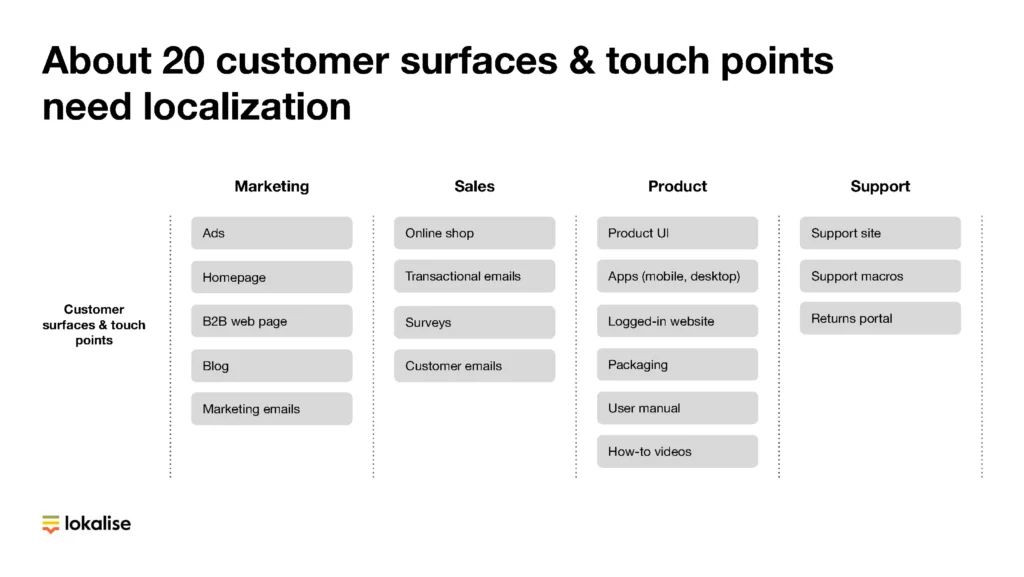
You will also need to consider that content can be localized to a different extent and for different purposes, especially if it’s not just text.
- If you want to introduce your product, you might translate the copy but keep the visuals in English.
- If you want to reassure the audience that they’ll be able to use the product, an effective way to do this is to show a picture of the localized product.
- If you want your audience to believe that your product is really easy to use, you might need a localized video to prove this.
The more elements there are to localize, the more skills are needed to do it, the longer it takes to coordinate all the stakeholders to get the final product, and the more their collective time will cost.
The challenge is to decide to which degree you want to localize existing content:
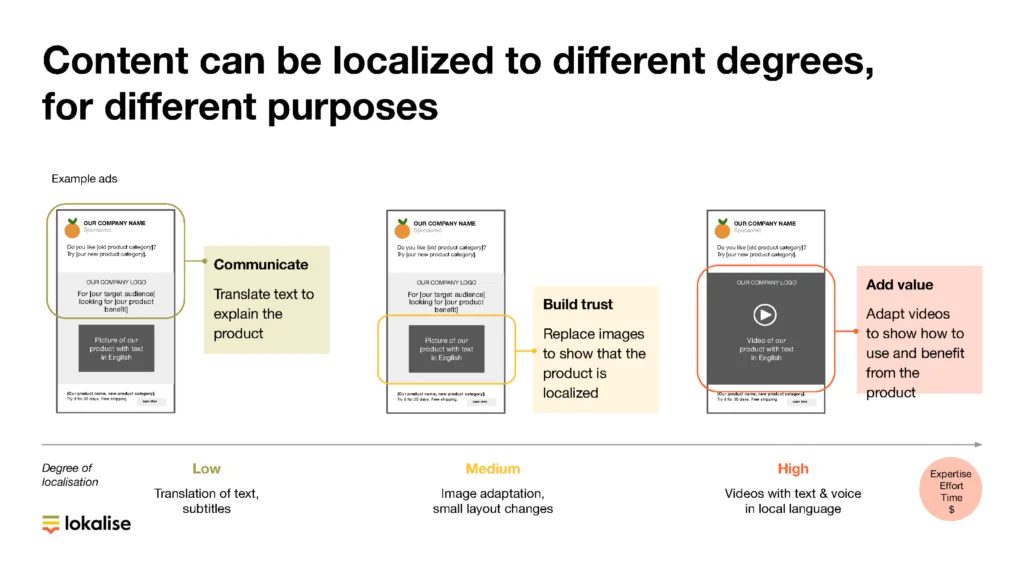
Define the degree of localization needed for different target markets
The degree of localization needed can vary significantly across markets and languages and must be balanced with customer expectations.
So you need to do the research and write down your observations, assumptions, and conclusions.
For example:
- Observation: In some non-English speaking countries conversion is very similar or even higher compared to English-speaking markets
- Assumption: High levels of education and income are highly correlated with English language proficiency → High overlap between our target segment and English-speaking population in some countries
- Conclusion: Localization is beneficial in countries with low level of English but high level of education and income
Once you’ve done the research, you can start to map out the level of localization needed by different target markets.

Localization expectations vary by touch point and target market, so you need to find a way to balance these. A good question to start with is:
What’s the extent of localization that would be enough for X market to buy the product?
And another layer of complexity on top of the differences in customer expectation is the difference between the target language and the one you would be translating from it’s a lot easier to translate from English into Spanish than into Arabic because you don’t need to change the layout across all customer surfaces to accommodate for the fact that the language is written right to left.
So your localization efforts should also balance the source to target language differences.
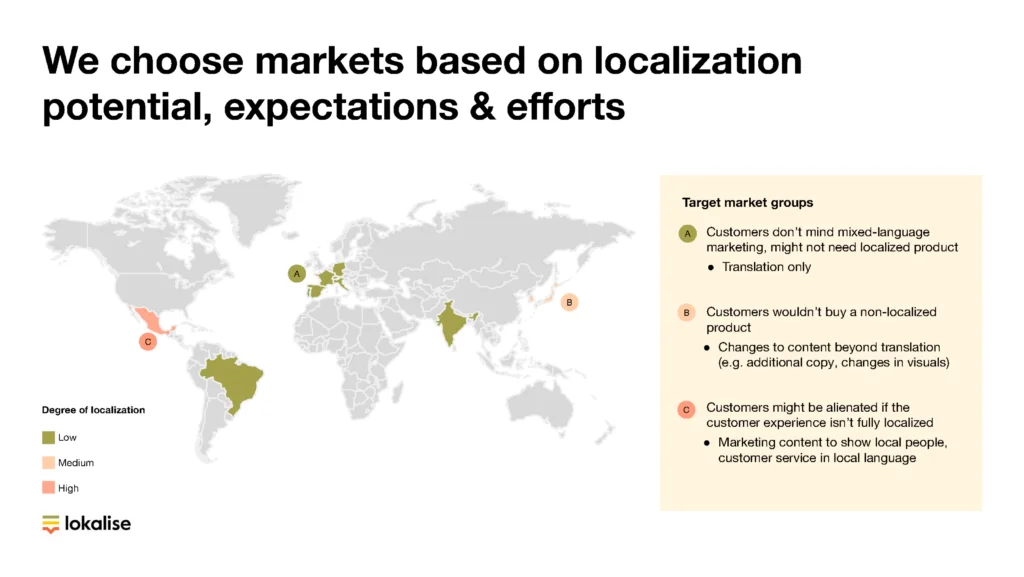
Write style guidelines for translators
It helps to create guidelines so that translators are in a position to make copy decisions.
Style guides should have do’s and don’ts, and an explanation of the reasoning behind them.
If you don’t want religious references in your translations, the best way to avoid them is to explain why you don’t want them in your brand messages.
For example:
● We don’t use words or phrases with strong religious connotations which might suggest that we want to express religious views and preferences.
● We choose to paraphrase or omit idioms when we risk saying something that can be

Building a style guide is an ongoing process, so learn from your translator’s mistakes, and keep updating your guidelines. Come up with better alternatives in similar scenarios and write down what you would and would not do in such situations and why.
Balance value with cost & complexity
Create an executive summary that outlines:
- What you will localize and how
- What you expect to achieve by doing localization in terms of business benefits
- How you will measure success in numbers
- How much it will all cost, how much revenue it will generate, and what kind of investment is needed
Here’s an example:
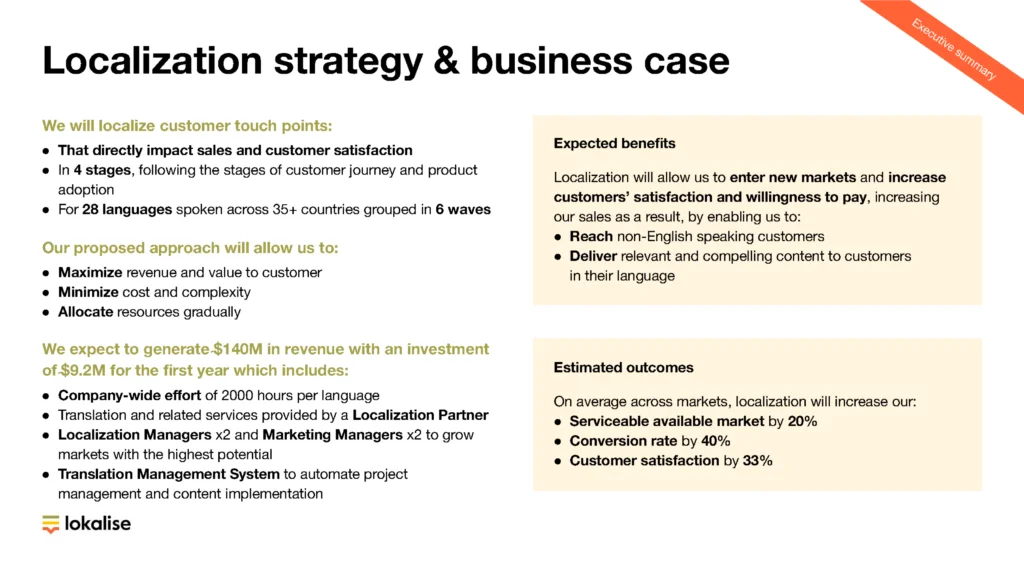
You might group markets based on the degree of localization your target customers expect. So you can also set expectations with stakeholders and sponsors around the efforts you put into support in the market entry and growth.
Estimate the profitability of your localization efforts and prioritize high-value, low-effort initiatives although you might decide to start with the easiest markets that are not necessarily the most profitable, so you can gain experience and maximize your chances of success when you enter markets that need more complex localization.
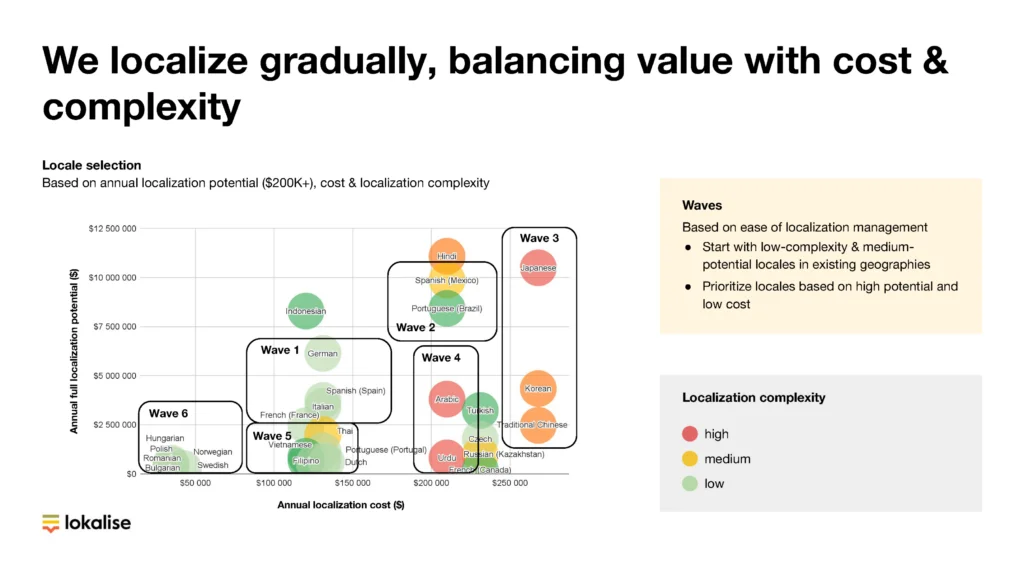
Localization efforts should also consider customer segmentation which, if you’re a product company, you might want to align with the stages of product adoption.
And when thinking about the investment, you need to look beyond the cost of language services and translation management systems.
You need to factor in the skills and the teams across the organization that localization would rely on, and the roles you’d need to introduce in the future.
Knowing all the capabilities you need, you can estimate the overall cost of supporting localization based on an estimate of how much content you would localize and to what degree.
Add your estimates for the extra revenue that our localization efforts would generate, and you have your business case.
Tip: keep a separate spreadsheet for all the related calculations and assumptions which you should adjust when you have more information, or when your assumptions change.
Conclusion
By going through this process, sponsors and stakeholders will get a much better understanding of localization and all its related challenges and costs.
They’ll be able to more accurately estimate the localization potential in different markets and choose which ones to enter, and in what order.
And because they have a better idea of which teams would need to be involved in the process, and when, they can better plan for localization and make sure that the right processes are in place, so the teams can actually deliver on what is expected of them.
It takes more time, effort, and investment to add your first languages, but then you gain efficiency later on. The result can lead to a significant growth opportunity for businesses willing to take the time to get it right.
Whether you’re just beginning to localize, or already doing so without a clear strategy, it’s never too late to develop one.



